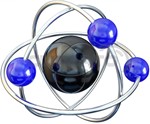Solution of the variant 61 KR №1 - chemisty Shimanovich
Content: Вариант 61.RAR (143.41 KB)
Uploaded: 01.06.2016
Positive responses: 0
Negative responses: 0
Sold: 1
Refunds: 0
Seller: Михаил_Перович
information about the seller and its items
Loyalty discount! If the total amount of your purchases from the seller more than:
| $1 | the discount is | 1% |
| $5 | the discount is | 2% |
| $10 | the discount is | 3% |
| $20 | the discount is | 5% |
| $50 | the discount is | 7% |
| $100 | the discount is | 10% |
| $200 | the discount is | 15% |
$2.53
The decision of the test No. 1 of option 61 of the collection on chemistry Shimanovich I.E.
(formatted in Microsoft Word)
Tasks:
3. From 1.35 g of metal oxide, 3.15 g of its nitrate is obtained. Calculate the equivalent mass of this metal. Answer: 32.5 g / mol
25. Which orbitals of the atom are filled with electrons earlier: 4s or 3d; 5s or 4p? Why? Write the electronic formula of the atom of the element with atomic number 21.
43. What is electronegativity? How does the electronegativity of p-elements change in the period, in the group of the periodic system, with an increase in the serial number? Why?
65. What covalent bond is called G-bond and what is n-bond? Examine the structure of the nitrogen molecule as an example.
90. The thermal effect of which reaction of combustion of liquid benzene with the formation of water vapor and carbon dioxide is -3135.58 kJ. Write a thermochemical equation for this reaction and calculate the heat of formation of С6Н6 (l). Answer: +49.03 kJ.
106. How can one explain that under standard conditions an exothermic reaction is impossible:
H2 (g) + CO2 (g) = CO (g) + H2O (g); H = -2.85 kJ?
Knowing the thermal effect of the reaction and the absolute standard entropies of the corresponding substances, determine the Go298 of this reaction.
Answer: +19.91 kJ.
131. The rate constant of the N2O decomposition reaction proceeding according to the equation 2N2O = 2N2 + O2 is equal to 5 • 10-4. Initial concentration of N2O = 6.0 mol / l. Calculate the initial reaction rate and its rate when 50% of the N2O decomposes. Answer: 1.8 • 10-2; 4.5 x 10-3.
148. What volume of a 20.01% HCl solution (square 1,100 g / cm3) is required to prepare 1 liter of a 10.17% solution (square 1.050 g / cm3)? Answer: 485.38 cm3
169. Calculate the cryoscopic constant of acetic acid, knowing that a solution containing 4.25 g of anthracene C14H10 in 100 g of acetic acid crystallizes at 15.718 ° C. The crystallization temperature of acetic acid is 16.65 ° C. Answer: 3.9 °.
191. Make the molecular equations of reactions, which are expressed by ion-molecular equations:
a) CaCO3 + 2H + = Ca2 + + H2O + CO2
b) A1 (OH) 3 + OH- = AlO-2 + 2H2O
c) Pb2 + + 2I- = PbI2
201. Make up the ionic-molecular and molecular equations of joint hydrolysis that occurs when mixing solutions of K2S and CrCl3. Each of the taken salts is hydrolyzed irreversibly to the end with the formation of the corresponding base and acid.
(formatted in Microsoft Word)
Tasks:
3. From 1.35 g of metal oxide, 3.15 g of its nitrate is obtained. Calculate the equivalent mass of this metal. Answer: 32.5 g / mol
25. Which orbitals of the atom are filled with electrons earlier: 4s or 3d; 5s or 4p? Why? Write the electronic formula of the atom of the element with atomic number 21.
43. What is electronegativity? How does the electronegativity of p-elements change in the period, in the group of the periodic system, with an increase in the serial number? Why?
65. What covalent bond is called G-bond and what is n-bond? Examine the structure of the nitrogen molecule as an example.
90. The thermal effect of which reaction of combustion of liquid benzene with the formation of water vapor and carbon dioxide is -3135.58 kJ. Write a thermochemical equation for this reaction and calculate the heat of formation of С6Н6 (l). Answer: +49.03 kJ.
106. How can one explain that under standard conditions an exothermic reaction is impossible:
H2 (g) + CO2 (g) = CO (g) + H2O (g); H = -2.85 kJ?
Knowing the thermal effect of the reaction and the absolute standard entropies of the corresponding substances, determine the Go298 of this reaction.
Answer: +19.91 kJ.
131. The rate constant of the N2O decomposition reaction proceeding according to the equation 2N2O = 2N2 + O2 is equal to 5 • 10-4. Initial concentration of N2O = 6.0 mol / l. Calculate the initial reaction rate and its rate when 50% of the N2O decomposes. Answer: 1.8 • 10-2; 4.5 x 10-3.
148. What volume of a 20.01% HCl solution (square 1,100 g / cm3) is required to prepare 1 liter of a 10.17% solution (square 1.050 g / cm3)? Answer: 485.38 cm3
169. Calculate the cryoscopic constant of acetic acid, knowing that a solution containing 4.25 g of anthracene C14H10 in 100 g of acetic acid crystallizes at 15.718 ° C. The crystallization temperature of acetic acid is 16.65 ° C. Answer: 3.9 °.
191. Make the molecular equations of reactions, which are expressed by ion-molecular equations:
a) CaCO3 + 2H + = Ca2 + + H2O + CO2
b) A1 (OH) 3 + OH- = AlO-2 + 2H2O
c) Pb2 + + 2I- = PbI2
201. Make up the ionic-molecular and molecular equations of joint hydrolysis that occurs when mixing solutions of K2S and CrCl3. Each of the taken salts is hydrolyzed irreversibly to the end with the formation of the corresponding base and acid.
No feedback yet
